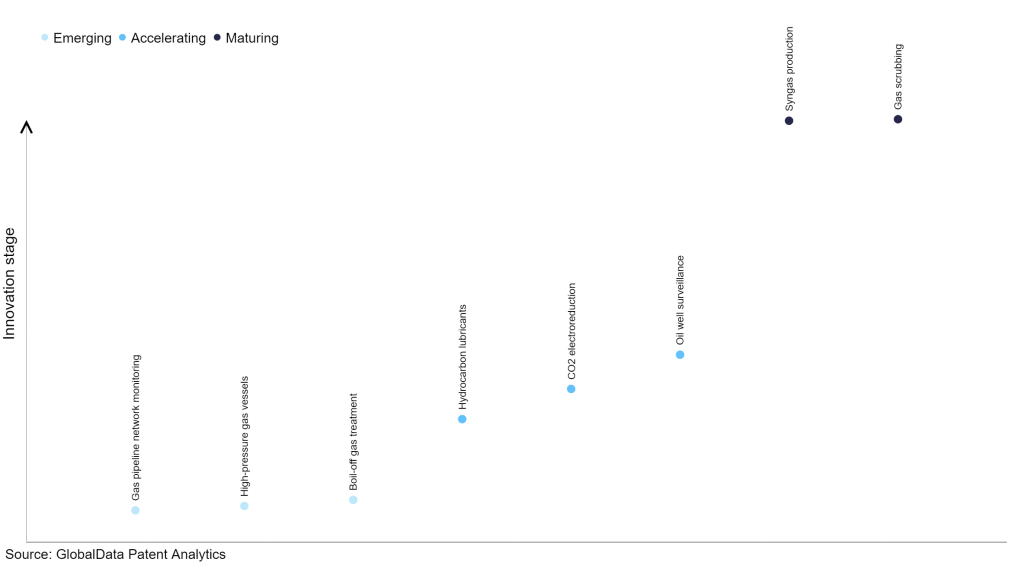The oil & gas industry continues to be a hotbed of patent innovation. Activity is driven by the need to improve efficiencies, increase safety, and reduce environmental impacts, and the growing importance of technologies such as artificial intelligence (AI), machine learning (ML), big data, blockchain, and robotics. In the last three years alone, there have been over 327,000 patents filed and granted in the oil & gas industry, according to GlobalData’s report on Innovation in oil & gas: oil well surveillance. Buy the report here.
However, not all innovations are equal and nor do they follow a constant upward trend. Instead, their evolution takes the form of an S-shaped curve that reflects their typical lifecycle from early emergence to accelerating adoption, before finally stabilizing and reaching maturity.
Identifying where a particular innovation is on this journey, especially those that are in the emerging and accelerating stages, is essential for understanding their current level of adoption and the likely future trajectory and impact they will have.
65+ innovations will shape the oil & gas industry
According to GlobalData’s Technology Foresights, which plots the S-curve for the oil & gas industry using innovation intensity models built on over 201,000 patents, there are 65+ innovation areas that will shape the future of the industry.
Within the emerging innovation stage, gas pipeline network monitoring, high-pressure gas vessels, and boil-off gas treatment are disruptive technologies that are in the early stages of application and should be tracked closely. Hydrocarbon lubricants, CO2 electroreduction and oil well surveillance are some of the accelerating innovation areas, where adoption has been steadily increasing. Among maturing innovation areas are syngas production and gas scrubbing, which are now well established in the industry.
Innovation S-curve for the oil & gas industry

Oil well surveillance is a key innovation area in oil & gas
Oil well surveillance refers to the monitoring and data collection activities carried out in oil wells to gather real-time information about the well conditions, including pressure, temperature, and flow. The surveillance helps in ensuring the safe and efficient operation of the well, as well as optimizing production and identifying potential issues or risks.
GlobalData’s analysis also uncovers the companies at the forefront of each innovation area and assesses the potential reach and impact of their patenting activity across different applications and geographies. According to GlobalData, there are 225+ companies, spanning technology vendors, established oil & gas companies, and up-and-coming start-ups engaged in the development and application of oil well surveillance.
Key players in oil well surveillance – a disruptive innovation in the oil & gas industry
‘Application diversity’ measures the number of applications identified for each patent. It broadly splits companies into either ‘niche’ or ‘diversified’ innovators.
‘Geographic reach’ refers to the number of countries each patent is registered in. It reflects the breadth of geographic application intended, ranging from ‘global’ to ‘local’.
Patent volumes related to oil well surveillance
Source: GlobalData Patent Analytics
Halliburton is one of the leading patent filers in oil well surveillance. Their SPIDR Data Acquisition System is a well surveillance and testing solution that records well data at the wellhead in both shut-in and flowing scenarios. SPIDR provides updates on a day-to-day basis and offers expert analysis. It also features quartz technology and works without any intervention of a well bore. Halliburton also offers ERD XHT downhole gauge system as part of its DataSphere permanent monitoring suite for real-time collection and monitoring of downhole data, particularly in extremely high-temperature environments. Some other key patent filers in the oil well surveillance industry include Baker Hughes, Schlumberger, and China National Petroleum.
In terms of application diversity, Halliburton leads the pack, while Baker Hughes and Schlumberger stood in the second and third positions, respectively. By means of geographic reach, Upwing Energy held the top position, followed by Weatherford International and Geomec Engineering.
Oil and gas companies are increasingly using oil well surveillance technologies to enable data-driven decisions, optimize production, reduce costs, and improve reservoir management.
To further understand the key themes and technologies disrupting the oil & gas industry, access GlobalData’s latest thematic research report on Oil & Gas.
Data Insights
From

The gold standard of business intelligence.
Blending expert knowledge with cutting-edge technology, GlobalData’s unrivalled proprietary data will enable you to decode what’s happening in your market. You can make better informed decisions and gain a future-proof advantage over your competitors.



